The power supply equipment for data center industry stands at the threshold of a decade-long expansion trajectory that promises to reshape critical infrastructure technology, digital transformation solutions, and high-availability power applications. The market's journey from USD 6,775.5 million in 2025 to USD 14,492.9 million by 2035 represents substantial growth, demonstrating the accelerating adoption of advanced power equipment formulations and premium reliability technology across internet data centers, financial infrastructure, and industrial manufacturing sectors.
The first half of the decade (2025-2030) will witness the market climbing from USD 6,775.5 million to approximately USD 9,909.5 million, adding USD 3,134.0 million in value, which constitutes 46% of the total forecast growth period. This phase will be characterized by the rapid adoption of uninterruptible power supply (UPS) systems, driven by increasing cloud computing expansion and the growing need for power reliability requirements worldwide. Advanced power management capabilities and flexible redundancy systems will become standard expectations rather than premium options.
The latter half (2030-2035) will witness sustained growth from USD 9,909.5 million to USD 14,492.9 million, representing an addition of USD 4,583.4 million or 54% of the decade's expansion. This period will be defined by mass market penetration of specialized power equipment designs, integration with comprehensive intelligent infrastructure platforms, and seamless compatibility with existing data center electrical systems. The market trajectory signals fundamental shifts in how operators approach power reliability and energy efficiency management, with participants positioned to benefit from sustained demand across multiple equipment types and application segments.
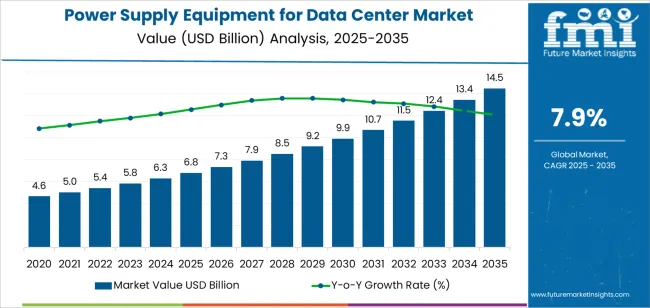
The Power Supply Equipment for Data Center market demonstrates distinct growth phases with varying market characteristics and competitive dynamics. Between 2025 and 2030, the market progresses through its digital infrastructure adoption phase, expanding from USD 6,775.5 million to USD 9,909.5 million with steady annual increments averaging 7.9% growth. This period showcases the transition from basic power distribution systems to advanced UPS/HVDC designs with enhanced energy efficiency capabilities and integrated power management systems becoming mainstream features.
The 2025-2030 phase adds USD 3,134 million to market value, representing 46% of total decade expansion. Market maturation factors include standardization of data center power and digital infrastructure protocols, declining component costs for specialized power equipment, and increasing industry awareness of uptime benefits reaching optimal reliability effectiveness in internet and financial applications. Competitive landscape evolution during this period features established equipment manufacturers like Hitachi Energy and Schneider Electric expanding their data center power portfolios while specialty manufacturers focus on advanced efficiency development and enhanced reliability capabilities.
From 2030 to 2035, market dynamics shift toward advanced power integration and global data center expansion, with growth continuing from USD 9,909.5 million to USD 14,492.9 million, adding USD 4,583.4 million or 54% of total expansion. This phase transition centers on specialized power supply systems, integration with artificial intelligence infrastructure networks, and deployment across diverse hyperscale and edge computing scenarios, becoming standard rather than specialized applications. The competitive environment matures with focus shifting from basic power delivery capability to comprehensive energy optimization systems and integration with data center infrastructure management platforms.
| Metric | Value |
|---|---|
| Market Value (2025) | USD 6,775.5 million |
| Market Forecast (2035) | USD 14,492.9 million |
| Growth Rate | 7.9% CAGR |
| Leading Technology | UPS/HVDC Equipment Type |
| Primary Application | Internet Segment |
The market demonstrates strong fundamentals with UPS/HVDC systems capturing a dominant share through advanced power protection and energy efficiency optimization capabilities. Internet applications drive primary demand, supported by increasing cloud infrastructure deployment and digital transformation technology requirements. Geographic expansion remains concentrated in developed markets with established data center infrastructure, while emerging economies show accelerating adoption rates driven by digitalization expansion and rising data processing standards.
Market expansion rests on three fundamental shifts driving adoption across the internet, financial services, and industrial manufacturing sectors. First, digital transformation demand creates compelling infrastructure advantages through power supply equipment that provides immediate uptime assurance and energy efficiency without compromising operational goals, enabling data center operators to meet stringent availability standards while maintaining processing capacity and reducing power costs. Second, cloud computing modernization accelerates as enterprises worldwide seek advanced power systems that complement virtualized infrastructure, enabling precise power management and reliability optimization that align with industry standards and service level agreements.
Third, hyperscale deployment enhancement drives adoption from internet giants and colocation providers requiring effective power solutions that maximize uptime while maintaining operational efficiency during peak load and maintenance operations. However, growth faces headwinds from capital expenditure challenges that vary across data center operators regarding the acquisition of redundant power equipment and infrastructure costs, which may limit adoption in cost-sensitive deployments. Technical limitations also persist regarding cooling integration and space constraints that may reduce effectiveness in dense computing environments and retrofit scenarios, which affect power efficiency and facility requirements.
The power supply equipment for data center market represents a mission-critical yet transformative infrastructure opportunity driven by expanding global digitalization, cloud computing growth, and the need for superior reliability in diverse computing applications. As operators worldwide seek to achieve optimal uptime, reduce energy consumption, and integrate advanced power systems with intelligent platforms, power supply equipment is evolving from basic electrical infrastructure to sophisticated energy management solutions ensuring operational excellence and efficiency leadership.
The market's growth trajectory from USD 6,775.5 million in 2025 to USD 14,492.9 million by 2035 at a 7.9% CAGR reflects fundamental shifts in data center industry reliability requirements and energy optimization. Geographic expansion opportunities are particularly pronounced in Asia Pacific markets, while the dominance of UPS/HVDC systems and internet applications provides clear strategic focus areas.
Strengthening the dominant UPS/HVDC segment (48.0% market share) through enhanced efficiency formulations, superior reliability performance, and integrated power management systems. This pathway focuses on optimizing system architecture, improving energy efficiency, extending operational effectiveness to optimal power protection rates, and developing specialized configurations for diverse applications. Market leadership consolidation through advanced power engineering and intelligent system integration enables premium positioning while defending competitive advantages against traditional transformer-based alternatives. Expected revenue pool: USD 650-890 million
Rapid data center construction and cloud computing growth across Asia Pacific creates substantial expansion opportunities through local equipment manufacturing capabilities and technology transfer partnerships. Growing internet penetration and digital economy initiatives drive sustained demand for advanced power supply systems. Localization strategies reduce import costs, enable faster technical support, and position companies advantageously for procurement programs while accessing growing domestic markets. Expected revenue pool: USD 520-730 million
Expansion within the dominant internet segment (42.0% market share) through specialized equipment designs addressing hyperscale standards and high-density power requirements. This pathway encompasses modular UPS systems, redundancy architecture integration, and compatibility with diverse cloud infrastructure operations. Premium positioning reflects superior availability assurance and comprehensive energy efficiency supporting modern internet operations. Expected revenue pool: USD 440-620 million
Strategic expansion into finance and insurance applications (28.0% market share) requires enhanced reliability features and specialized power systems addressing financial transaction operational requirements. This pathway addresses tier III/IV data center integration, regulatory compliance enhancement, and mission-critical systems with advanced redundancy engineering for demanding financial standards. Premium pricing reflects specialized reliability requirements and zero-downtime expectations. Expected revenue pool: USD 360-510 million
Development of specialized transformer formulations (26.0% share) and LV/MV switchgear systems (26.0%), addressing specific voltage requirements and distribution demands. This pathway encompasses energy-efficient designs, compact footprint optimization, and cost-effective alternatives for diverse facility segments. Technology differentiation through modular architectures enables diversified revenue streams while reducing dependency on single equipment platforms. Expected revenue pool: USD 290-420 million
Expansion of industrial manufacturing application segment (18.0% market share) through enhanced ruggedized designs, superior environmental compatibility, and specialized production requirements. This pathway encompasses factory data center applications, industrial IoT infrastructure, and specialty equipment requiring reliable power characteristics. Market development through industrial sector partnerships enables differentiated positioning while accessing manufacturing markets requiring dependable power solutions. Expected revenue pool: USD 230-340 million
Development of government departments (8.0% share) and other applications (4.0%) addressing security requirements and specialized missions across defense and public service scenarios. This pathway encompasses secure facility power systems, compliance-ready equipment, and comprehensive documentation. Market positioning reflects security capabilities and regulatory compliance while enabling access to government sector programs and critical infrastructure partnerships. Expected revenue pool: USD 180-270 million
Primary Classification: The market segments by equipment type into Transformer, LV/MV Switchgear, and UPS/HVDC categories, representing the evolution from basic power distribution to advanced protection solutions for comprehensive data center power optimization.
Secondary Classification: Application segmentation divides the market into Internet, Finance and Insurance, Industrial Manufacturing, Government Departments, and Others sectors, reflecting distinct requirements for reliability levels, redundancy architecture, and power density.
Regional Classification: Geographic distribution covers Asia Pacific, Europe, North America, and other regions, with developed markets leading adoption while emerging economies show accelerating growth patterns driven by digital infrastructure expansion programs.
The segmentation structure reveals technology progression from traditional transformer-based power distribution toward advanced UPS and HVDC systems with enhanced efficiency and reliability capabilities, while application diversity spans from internet data centers to specialized financial and government facilities requiring mission-critical power solutions.
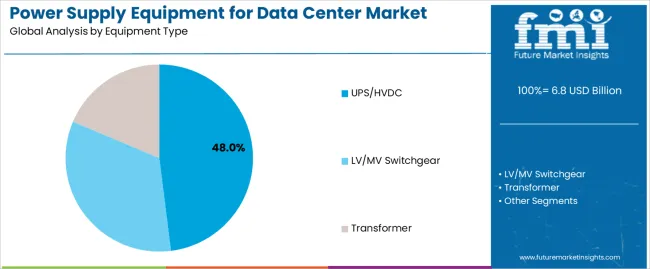
Market Position: UPS/HVDC systems command the leading position in the Power Supply Equipment for Data Center market with approximately 48% market share through superior protection properties, including instantaneous power backup capability, voltage regulation functionality, and energy efficiency that enable operators to achieve optimal uptime across diverse internet and financial data center environments.
Value Drivers: The segment benefits from operator preference for critical power protection that provides consistent power quality, seamless backup transition, and operational reliability without requiring generator startup delays. Advanced protection features enable redundant configuration systems, battery management integration, and compatibility with existing data center electrical infrastructure, where power continuity and efficiency represent critical operational requirements.
Competitive Advantages: UPS/HVDC systems differentiate through proven reliability effectiveness, energy efficiency characteristics, and integration with modular data center architectures that enhance operational uptime while maintaining optimal power conversion efficiency suitable for diverse hyperscale facilities, colocation centers, and enterprise data centers. The segment's dominance is reinforced by comprehensive industry validation across major cloud providers and data center operators, established tier certification supporting uptime institute standards, and continuous innovation in power topology that addresses evolving computing requirements and energy efficiency regulations.
Key market characteristics:
Transformer systems maintain significant market positioning in the Power Supply Equipment for Data Center market with approximately 26.0% market share due to their voltage conversion properties and distribution advantages. These systems appeal to operators requiring reliable power transformation with adequate performance for medium-voltage applications. Market adoption is driven by large-scale data center expansion, highlighting dependable voltage conversion solutions and operational capacity through optimized transformer designs while maintaining competitive infrastructure costs.
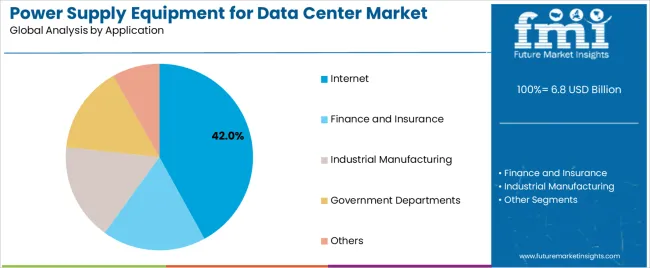
Market Context: Internet applications dominate the Power Supply Equipment for Data Center market with approximately 42% market share due to widespread adoption of cloud infrastructure and increasing focus on service availability, computational capacity, and global connectivity applications that minimize downtime while maintaining digital service industry standards.
Appeal Factors: Internet companies prioritize power reliability, scalability, and integration with existing hyperscale infrastructure that enables coordinated power management across multiple data center facilities. The segment benefits from substantial technology investment and digital transformation programs that emphasize the acquisition of power equipment for uptime optimization and capacity expansion applications.
Growth Drivers: Cloud service expansion programs incorporate advanced power supply equipment as standard infrastructure for modern hyperscale operations, while artificial intelligence workload growth increases demand for high-density power capabilities that comply with energy efficiency standards and optimize operational costs. The growing emphasis on edge computing deployment is driving demand for distributed power supply systems that maintain consistent reliability across geographically dispersed facilities, while increasing data sovereignty requirements necessitate operators to implement localized infrastructure with redundant power protection to support regulatory compliance and service quality maintenance throughout global content delivery networks.
Market Challenges: Varying service level agreements and workload characteristics may limit power system standardization across different data center types or deployment models.
Application dynamics include:
Finance and insurance applications capture approximately 28.0% market share through mission-critical requirements in banking operations, trading platforms, and insurance processing scenarios demanding ultra-reliable power supply systems capable of maintaining continuous availability under all conditions while providing exceptional redundancy and instantaneous failover capabilities to support zero-tolerance downtime expectations.
Industrial manufacturing accounts for approximately 18.0% market share through production continuity requirements and industrial IoT infrastructure, government departments capture 8.0% through security and compliance needs, while other segments represent 4.0% including healthcare, telecommunications, and research applications requiring power supply capabilities for diverse operational reliability and regulatory compliance.
Growth Accelerators: Digital transformation drives primary adoption as power supply equipment provides uptime assurance capabilities that enable data center operators to meet availability standards without excessive infrastructure redundancy, supporting business continuity and service delivery that require optimal power reliability applications. Cloud computing expansion demand accelerates market expansion as providers seek effective power systems that maximize facility utilization while maintaining operational effectiveness during capacity growth and technology refresh scenarios. Technology sector spending increases worldwide, creating sustained demand for advanced power supply systems that complement modern data center designs and provide competitive advantages in reliability-focused markets.
Growth Inhibitors: Capital expenditure challenges vary across data center operators regarding the acquisition of redundant power equipment and electrical infrastructure costs, which may limit operational flexibility and market penetration in regions with constrained budgets or emerging market deployments. Technical performance limitations persist regarding physical footprint constraints and cooling integration complexity that may reduce effectiveness in high-density computing, urban locations, or retrofit installation conditions, affecting facility efficiency and space requirements. Market fragmentation across multiple data center tier standards and redundancy architectures creates system design concerns between different equipment suppliers and existing electrical infrastructure.
Market Evolution Patterns: Adoption accelerates in internet and financial sectors where availability justifies power equipment investment costs, with geographic concentration in developed markets transitioning toward rapid adoption in emerging economies driven by digitalization expansion and cloud infrastructure growth. Technology development focuses on enhanced energy efficiency, improved lithium-ion battery integration, and compatibility with renewable energy sources that optimize operational sustainability and cost effectiveness. The market could face disruption if alternative power technologies or distributed generation systems significantly change the architecture of data center electrical systems, though centralized power supply equipment's combination of proven reliability, efficiency optimization, and scalability continues to make it essential in mission-critical data center infrastructure.
The Power Supply Equipment for Data Center market demonstrates varied regional dynamics with Growth Leaders including China (10.7% CAGR) and India (9.9% CAGR) driving expansion through data center capacity additions and digital infrastructure programs. Steady Performers encompass Germany (9.1% CAGR), Brazil (8.3% CAGR), and United States (7.5% CAGR), benefiting from established technology industries and advanced cloud adoption. Mature Markets feature United Kingdom (6.7% CAGR) and Japan (5.9% CAGR), where specialized financial applications and premium power integration support consistent growth patterns.
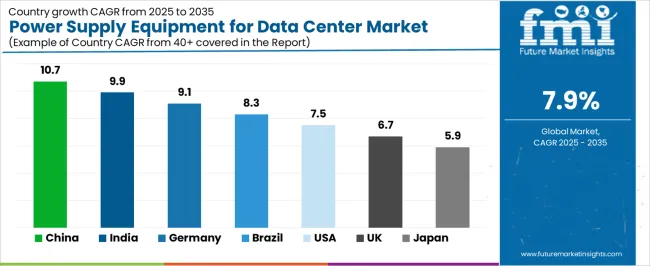
| Country | CAGR (2025-2035) |
|---|---|
| China | 10.7% |
| India | 9.9% |
| Germany | 9.1% |
| Brazil | 8.3% |
| United States | 7.5% |
| United Kingdom | 6.7% |
| Japan | 5.9% |
Regional synthesis reveals Asia Pacific markets leading adoption through data center construction expansion and digital economy infrastructure development, while European countries maintain strong expansion supported by advanced data sovereignty regulations and colocation facility requirements. North American markets show robust growth driven by hyperscale deployment applications and cloud service provider integration trends.
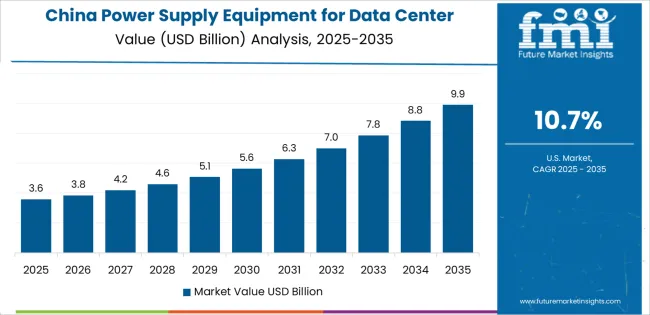
The Chinese market emphasizes advanced power infrastructure features, including high-efficiency UPS designs and integration with comprehensive data center platforms that manage power distribution, energy monitoring, and efficiency applications through unified facility management systems. The country demonstrates strong growth at 10.7% CAGR, driven by massive data center construction, internet economy expansion, and emerging artificial intelligence infrastructure development that support power equipment integration. Chinese operators prioritize operational effectiveness with power supply equipment delivering consistent availability through advanced redundancy capabilities and energy adaptation features.
Technology deployment channels include major internet companies, colocation providers, and telecommunications operators that support professional applications for complex hyperscale facilities and carrier-neutral operations. Infrastructure platform integration capabilities with established cloud systems expand market appeal across diverse operational requirements seeking reliability and efficiency benefits. The expanding digital economy and accelerating 5G deployment create sustained demand, while innovative applications in AI computing infrastructure and edge data centers open new growth avenues.
Performance Metrics:
Germany's advanced technology market demonstrates sophisticated power equipment deployment with documented operational effectiveness in colocation facilities and enterprise data centers through integration with existing electrical systems and infrastructure. The country leverages engineering expertise in power reliability and energy efficiency systems integration to maintain strong growth at 9.1% CAGR. Industrial centers, including Frankfurt, Munich, and Berlin, showcase premium installations where power supply systems integrate with comprehensive data center platforms and energy management systems to optimize uptime performance and operational effectiveness.
German operators prioritize system efficiency and EU energy compliance in equipment selection, creating demand for premium power supply systems with superior features, including regenerative technology and comprehensive monitoring capabilities. The market benefits from established data center infrastructure and a willingness to invest in power reliability technologies that provide long-term operational benefits and compliance with international energy efficiency and sustainability standards.
Market Intelligence Brief:
The USA power supply equipment for data center market demonstrates sophisticated deployment across hyperscale and enterprise applications with documented effectiveness in cloud operations and colocation facilities through integration with comprehensive infrastructure systems and energy optimization platforms. The country leverages advanced technology capabilities in power innovation and efficiency optimization technologies to maintain robust growth at 7.5% CAGR. Technology centers, including Northern Virginia, Silicon Valley, and Dallas, showcase extensive installations where power supply systems integrate with comprehensive cloud platforms and facility networks to optimize operational efficiency and reliability effectiveness.
American operators prioritize scalability and energy efficiency in equipment selection, creating demand for innovative power supply systems with advanced features, including modular architecture and comprehensive DCIM integration. The market benefits from established hyperscale infrastructure and willingness to invest in power technologies that provide long-term efficiency benefits and compliance with energy efficiency standards and corporate sustainability commitments.
Market Intelligence Brief:
The UK power supply equipment for data center market demonstrates advanced reliability deployment with documented operational effectiveness in financial applications and colocation facilities through integration with existing infrastructure compliance systems and operational requirements. The country leverages regulatory expertise in data center reliability and power systems integration to maintain steady growth at 6.7% CAGR. Technology centers, including London, Manchester, and Edinburgh, showcase installations where power supply systems integrate with comprehensive reliability platforms and redundancy management systems to optimize compliance and operational effectiveness.
British operators prioritize system reliability and regulatory compliance in equipment selection, creating demand for certified power supply systems with advanced features, including tier III/IV compatibility and comprehensive documentation. The market benefits from established financial sector infrastructure and commitment to invest in power reliability technologies that provide long-term business continuity benefits and compliance with UK and EU data protection and operational resilience standards. Financial applications, colocation operations, and government systems drive diversified demand across multiple sectors.
Strategic Market Indicators:
India's power supply equipment for data center market demonstrates rapid expansion deployment with documented operational effectiveness in cloud infrastructure and colocation facilities through integration with emerging digital systems and technology infrastructure. The country leverages growing IT capabilities in data center technology and cloud systems integration to achieve high growth at 9.9% CAGR. Technology centers, including Mumbai, Bangalore, and Hyderabad, showcase expanding installations where power supply systems integrate with comprehensive cloud platforms and colocation networks to optimize market penetration and operational effectiveness.
Indian operators prioritize cost-effectiveness and operational reliability in equipment selection, creating demand for scalable power supply systems with competitive features, including proven performance and local support capabilities. The market benefits from expanding digital infrastructure and willingness to invest in power reliability that provides business continuity benefits and compliance with emerging data center standards.
Market Intelligence Brief:
Brazil's power supply equipment for data center market demonstrates growth deployment with documented operational effectiveness in internet applications and financial facilities through integration with established technology systems and operational infrastructure. The country leverages digital economy capabilities in cloud infrastructure and data center operations to achieve growth at 8.3% CAGR. Technology centers, including São Paulo, Rio de Janeiro, and Brasília, showcase installations where power supply systems integrate with internet service platforms and financial operations to optimize reliability and operational effectiveness.
Brazilian operators prioritize operational reliability and local manufacturing in equipment selection, creating demand for robust power supply systems with proven performance and regional support. The market benefits from established telecommunications infrastructure and growing cloud services sector that provides sustained demand for data center power technology.
Market Intelligence Brief:
Japan's power supply equipment for data center market demonstrates precision deployment with documented operational effectiveness in financial applications and enterprise facilities through integration with advanced infrastructure systems and quality control requirements. The country leverages engineering excellence in precision power technology and data center systems integration to maintain steady growth at 5.9% CAGR. Technology centers, including Tokyo, Osaka, and Nagoya, showcase premium installations where power supply systems integrate with comprehensive quality platforms and reliability monitoring systems to optimize operational excellence and uptime effectiveness.
Japanese operators prioritize system precision and operational reliability in equipment selection, creating demand for premium power supply systems with advanced features, including earthquake-resistant designs and comprehensive redundancy. The market benefits from established enterprise infrastructure and commitment to invest in highest-quality power equipment that provides superior reliability and compliance with stringent Japanese data center standards.
Strategic Market Indicators:
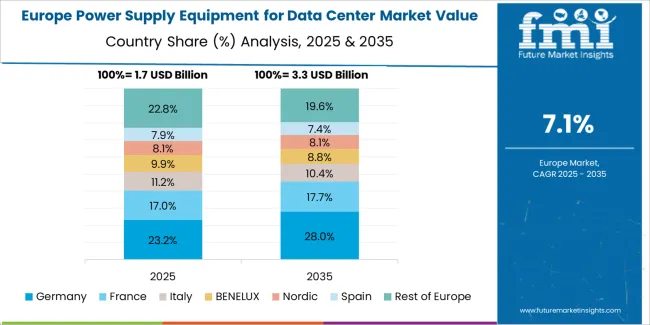
The Power Supply Equipment for Data Center market in Europe is projected to grow substantially over the forecast period, with Germany expected to maintain its leadership position with a significant market share supported by its advanced data center infrastructure and major colocation facilities in Frankfurt and Munich. The United Kingdom follows with strong market presence, driven by comprehensive financial data center programs and cloud infrastructure initiatives. France holds substantial market share through specialized internet applications, enterprise data centers, and government facility operations. The Netherlands commands notable market presence through strong Amsterdam Internet Exchange connectivity and colocation projects. Ireland accounts for growing market share aided by hyperscale deployment expansion and cloud provider adoption. Spain maintains steady share driven by specialty colocation applications and telecommunications demand. The Rest of Europe region is anticipated to show steady adoption, reflecting consistent growth in Nordic countries, data center expansion in Central European markets, and power infrastructure upgrades across Eastern European technology facilities.
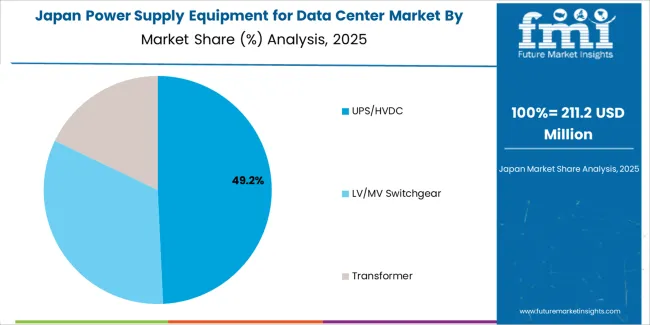
In Japan, the Power Supply Equipment for Data Center market prioritizes UPS/HVDC systems, which capture the dominant share of financial and enterprise installations due to their advanced features, including instantaneous backup optimization and seamless integration with existing data center electrical infrastructure. Japanese operators emphasize reliability, efficiency, and long-term operational excellence, creating demand for UPS/HVDC systems that provide consistent power protection capabilities and superior energy efficiency performance based on facility requirements and uptime standards. Transformer systems maintain secondary positions primarily in large-scale facilities and distribution applications where voltage conversion functionality meets operational requirements without compromising power quality.
Market Characteristics:
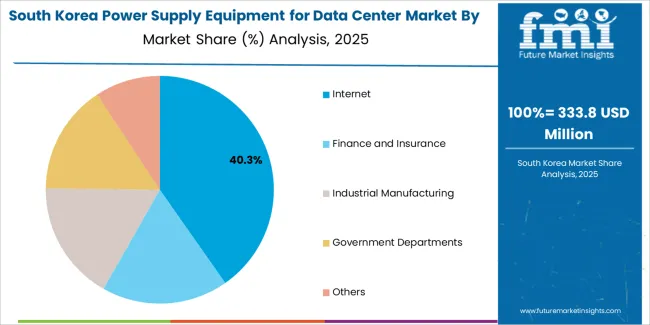
In South Korea, the market structure favors international power equipment manufacturers, including Hitachi Energy (ABB), Schneider Electric, and Siemens, which maintain dominant positions through comprehensive product portfolios and established data center networks supporting both internet infrastructure and financial facility installations. These providers offer integrated solutions combining advanced power supply systems with professional engineering services and ongoing technical support that appeal to Korean operators seeking reliable data center infrastructure. Local equipment manufacturers and system integrators capture moderate market share by providing localized support capabilities and competitive pricing for standard power equipment installations, while domestic technology companies focus on specialized applications and cost-effective solutions tailored to Korean data center market characteristics.
Channel Insights:
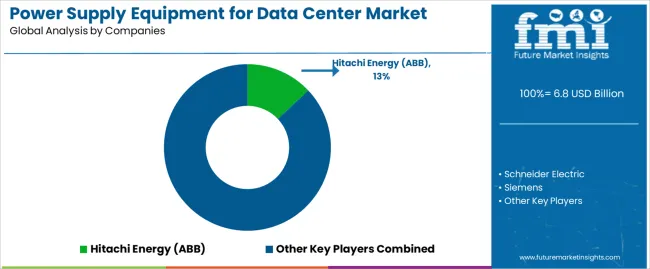
The Power Supply Equipment for Data Center market operates with moderate concentration, featuring approximately 40-50 meaningful participants, where leading companies control roughly 40-45% of the global market share through established data center relationships and comprehensive power equipment portfolios. Competition emphasizes reliability performance, energy efficiency, and technical support strength rather than price-based rivalry. Leading companies maintain market presence through extensive power supply product lines and global data center industry integration.
Market Leaders encompass Hitachi Energy (ABB), Schneider Electric, and Siemens, which maintain competitive advantages through extensive electrical infrastructure expertise, global technical support networks, and comprehensive data center integration capabilities that create customer loyalty and support premium pricing. These companies leverage decades of power equipment experience and ongoing innovation investments to develop advanced power supply systems with efficiency optimization and reliability features. Technology Innovators include GE and Eaton, which compete through specialized power technology focus and innovative energy management capabilities that appeal to data center operators seeking advanced infrastructure solutions and operational efficiency.
These companies differentiate through rapid certification development cycles and specialized hyperscale application focus. Regional Specialists feature power equipment manufacturers focusing on specific geographic markets and specialized applications, including modular systems and integrated infrastructure solutions. Market dynamics favor participants that combine proven reliability performance with advanced energy efficiency capabilities, including comprehensive monitoring support and predictive maintenance optimization features. Competitive pressure intensifies as traditional electrical equipment suppliers expand into data center applications, while information technology companies challenge established players through software-defined power solutions and intelligent infrastructure platforms targeting hyperscale and edge computing segments.
| Item | Value |
|---|---|
| Quantitative Units | USD 6,775.5 million |
| Equipment Type | Transformer, LV/MV Switchgear, UPS/HVDC |
| Application | Internet, Finance and Insurance, Industrial Manufacturing, Government Departments, Others |
| Regions Covered | Asia Pacific, Europe, North America, Latin America, Middle East & Africa |
| Countries Covered | China, India, Germany, Brazil, United States, United Kingdom, Japan, and 20+ additional countries |
| Key Companies Profiled | Hitachi Energy (ABB), Schneider Electric, Siemens, GE, Eaton, Hainan Jinpan Smart Technology, Eaglerise, Virginia Transformer, and 23+ additional companies |
| Additional Attributes | Dollar sales by equipment type and application categories, regional adoption trends across Asia Pacific, Europe, and North America, competitive landscape with power equipment manufacturers and data center infrastructure suppliers, operator preferences for reliability and energy efficiency, integration with data center infrastructure platforms and facility management systems, innovations in UPS technology and power excellence, and development of modular solutions with enhanced efficiency performance and operational optimization capabilities. |
The global power supply equipment for data center market is estimated to be valued at USD 6.8 billion in 2025.
The market size for the power supply equipment for data center market is projected to reach USD 14.5 billion by 2035.
The power supply equipment for data center market is expected to grow at a 7.9% CAGR between 2025 and 2035.
The key product types in power supply equipment for data center market are ups/hvdc, lv/mv switchgear and transformer.
In terms of application, internet segment to command 42.0% share in the power supply equipment for data center market in 2025.






Full Research Suite comprises of:
Market outlook & trends analysis
Interviews & case studies
Strategic recommendations
Vendor profiles & capabilities analysis
5-year forecasts
8 regions and 60+ country-level data splits
Market segment data splits
12 months of continuous data updates
DELIVERED AS:
PDF EXCEL ONLINE
Power Ring Rolling Machine Market Size and Share Forecast Outlook 2025 to 2035
Power Plant Boiler Market Size and Share Forecast Outlook 2025 to 2035
Power Electronics Market Size and Share Forecast Outlook 2025 to 2035
Power Tools Market Size and Share Forecast Outlook 2025 to 2035
Power Window Lift Motor Market Size and Share Forecast Outlook 2025 to 2035
Powered Surgical Staplers Market Size and Share Forecast Outlook 2025 to 2035
Power Distribution Component Market Size and Share Forecast Outlook 2025 to 2035
Power Over Ethernet (PoE) Controllers Market Size and Share Forecast Outlook 2025 to 2035
Power Inverter Market Size and Share Forecast Outlook 2025 to 2035
Power Sports Market Size and Share Forecast Outlook 2025 to 2035
Power Conditioner Market Size and Share Forecast Outlook 2025 to 2035
Power Control Commercial Surge Protection Devices Market Size and Share Forecast Outlook 2025 to 2035
Power Transmission Component Market Size and Share Forecast Outlook 2025 to 2035
Power Optimizer Market Size and Share Forecast Outlook 2025 to 2035
Power Plants Heavy Duty Gas Turbine Market Size and Share Forecast Outlook 2025 to 2035
Power Over Ethernet (PoE) Solutions Market Size and Share Forecast Outlook 2025 to 2035
Power Management System Market Analysis - Size, Share, and Forecast Outlook 2025 to 2035
Power Line Communication (PLC) Market Size and Share Forecast Outlook 2025 to 2035
Power Quality Meter Market Size and Share Forecast Outlook 2025 to 2035
Power Generation Gas Turbine Market Size and Share Forecast Outlook 2025 to 2035

Thank you!
You will receive an email from our Business Development Manager. Please be sure to check your SPAM/JUNK folder too.
Chat With
MaRIA